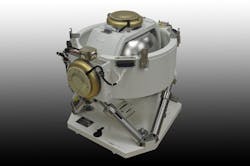Northrop Grumman to provide legacy AN/WSN-7 ring laser gyro inertial navigation for shipboard electronics
MECHANICSBURG, Pa. – U.S. Navy shipboard navigation and guidance specialists are continuing their efforts extend the life of the AN/WSN-7 ring laser gyro navigation system for Navy surface vessels and submarines.
Officials of the Naval Supply Systems Command Weapon Systems Support activity in Mechanicsburg, Pa., announced a $12.5 million contract Wednesday to the Northrop Grumman Corp. operating unit in Charlottesville, Va., for 12 items in support of the WSN-7 ship inertial navigation system.
The AN/WSN-7 is a self-contained ring laser gyro inertial navigation system that senses ship motions, computes the ship's precise position, velocity, attitude, heading, and rates in digital and analog formats, and forwards the data to other vital ship systems.
The WSN-7 has been in service with the Navy for decades, and was designed as a replacement for spinning-mass gyro navigation equipment aboard Navy warships. The system is as a more reliable ring laser gyro-based replacement for the old WSN-2 navigation system.
Navy officials are extending the life of the WSN-7 shipboard electronics as long as possible as they develop a WSN-7 replacement -- the new AN/WSN-12 inertial sensor module (ISM), a next-generation sensor that improves maritime navigation in GPS-denied environments for surface ships and submarines.
The AN/WSN-7 uses 25-year-old technology based on the NATO MK49 inertial navigation system deployed in the late 1980s. The INS-R will provide improved real-time navigation for Navy surface warships, and enable future technology growth.
The standard WSN-7 shipboard configuration consists of two independent cabinets for redundancy and survivability. It is not be susceptible to jamming or detection by enemy forces.
The ring laser gyro uses two counter-propagating laser beams operating on different frequencies with the difference dependent on rotation rate. Measurement of this difference provides the rotation angle or rotation rate about the device's sensitive axis.
Compared with older spinning-mass gyro navigation systems, ring laser gyros are much smaller, do not resist changes in direction, are frictionless, have low power consumption, and feature almost no moving parts to enhance reliability while still providing adequate accuracy.
The Navy awarded Northrop Grumman a production contract last June for the AN/WSN-12, which provides maritime positioning data with or without GPS, and is a key component of the U.S. Navy’s AN/WSN-12 Inertial Navigator System (INS), upgrading the Northrop Grumman built AN/WSN-7 INS.
Surface ships and submarines rely heavily on the positioning data provided by GPS for navigation, for safety at sea, and to fire weapons. The AN/WSN-12 ISM helps establish assured position, navigation, and timing (A-PNT) maritime solutions in the absence of satellite navigation technology.
Related: Northrop Grumman eyes new Navy shipboard navigation to replace aging AN/WSN-7
The first ISM was to be fielded this year, Northrop Grumman officials say. Northrop Grumman reported completion of the ISM's preliminary design review in May 2016, and critical design review in June 2018.
The AN/WSN-12 will help will provide mission critical ship positioning, velocity, and altitude data to shipboard sensors, combat systems, guns, and missile systems. It will use an open-systems architecture using a modular design, standards-based interfaces, and widely supported consensus-based standards.
On this contract Northrop Grumman will do the work in Charlottesville, Va., and should be finished by June 2028. For more information contact Northrop Grumman online at www.northropgrumman.com/what-we-do/sea, or the Naval Supply Systems Command Weapon Systems Support activity at www.navsup.navy.mil/NAVSUP-Enterprise/NAVSUP-Weapon-Systems-Support.
